Like a living art gallery, your indoor space can showcase nature’s most striking masterpieces through carefully chosen houseplants. You’ll discover how these botanical wonders, from the prayer plant’s dramatic stripes to the purple passion’s velvet textures, can transform ordinary rooms into exotic sanctuaries. Whether you’re drawn to bold patterns or subtle variations, these 15 remarkable specimens offer unique ways to bring the wild beauty of foliage into your home.

Contents
1. Prayer Plant
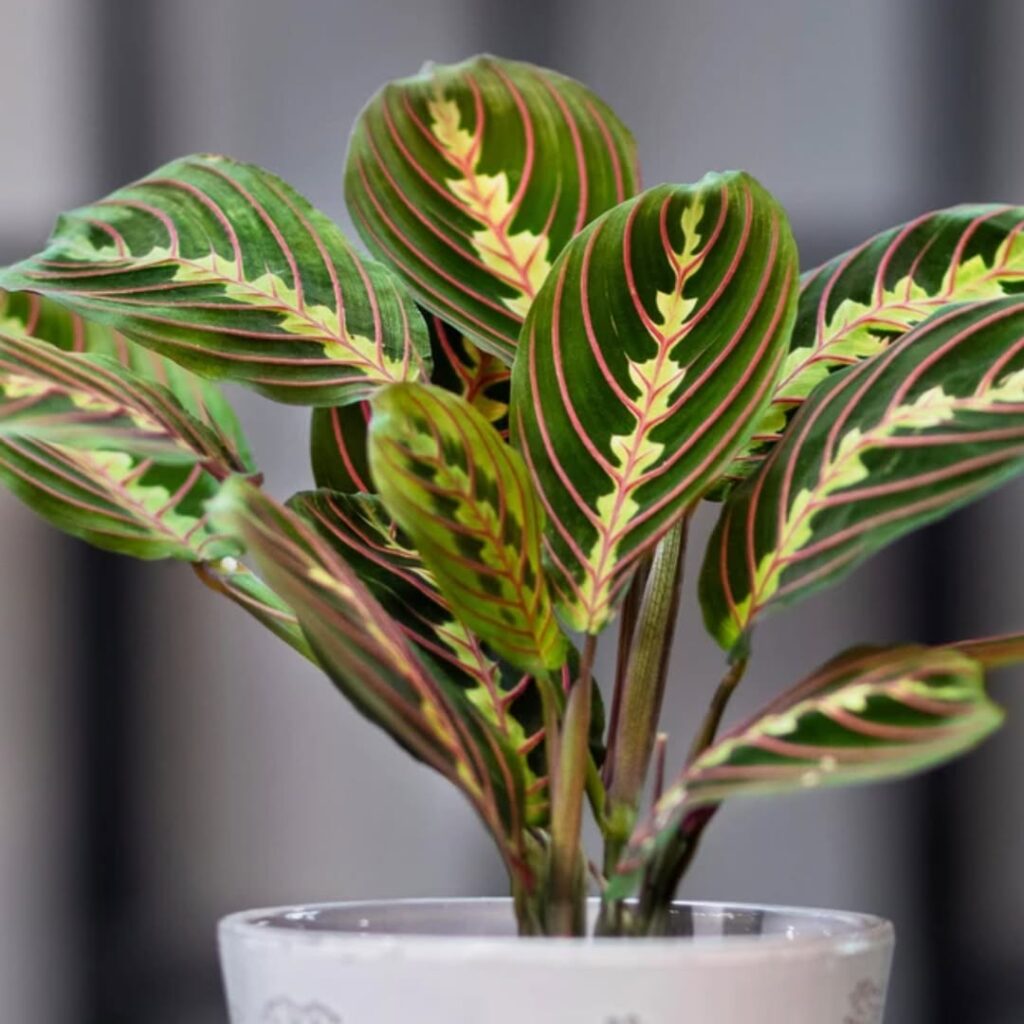
The Striped Prayer Plant (Maranta leuconeura) is a striking tropical plant known for its distinctive oval-shaped leaves marked with beautiful dark green stripes and red veins against a lighter green background. Its common name comes from the unique daily movement of its leaves – they lay flat during the day and fold upward like praying hands at night. This low-growing plant typically reaches 6-12 inches in height and spreads horizontally, making it an excellent choice for hanging baskets or as ground cover in terrariums.
- Light: Bright indirect light; avoid direct sunlight which can fade the leaf patterns
- Water: Keep soil consistently moist but not waterlogged; water when top inch of soil feels dry
- Humidity: High humidity (50% or higher); mist regularly or use a humidity tray
- Soil: Well-draining, rich potting mix with added peat moss
- Temperature: 65-80°F (18-27°C); protect from cold drafts
- Fertilizer: Feed monthly during growing season with balanced liquid fertilizer
- pH: 5.5-6.0 (slightly acidic)
2. Chinese Evergreen
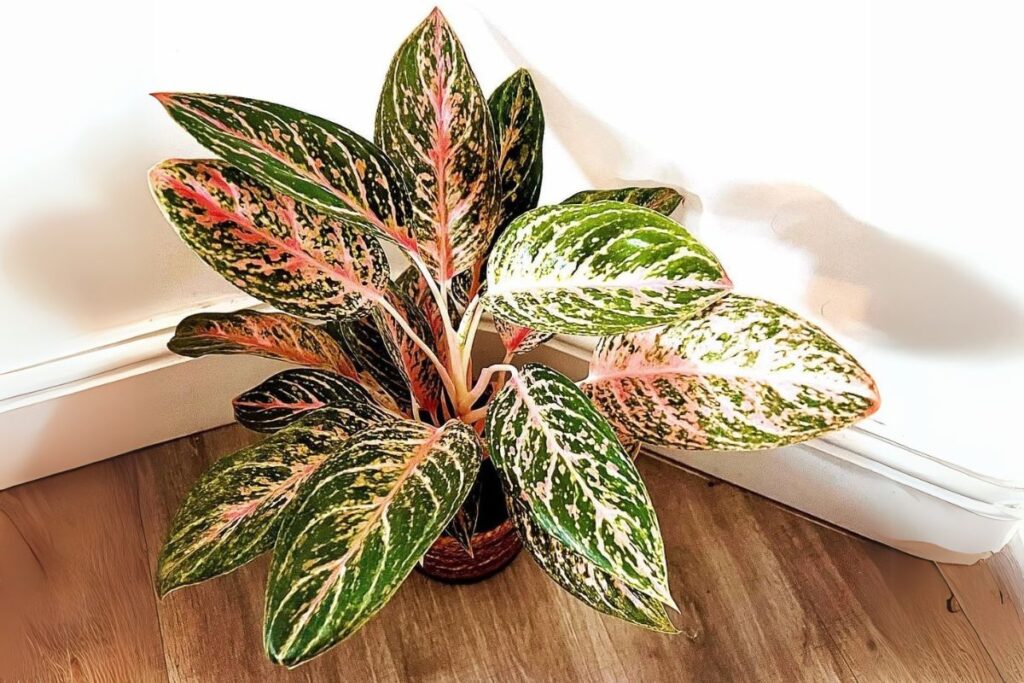
Chinese Evergreen (Aglaonema) plants are renowned for their striking silvery leaf patterns, featuring intricate designs that range from speckles to bold streaks across their dark green foliage. These metallic patterns create a stunning visual effect that makes them stand out among other houseplants, with some varieties displaying silvery-white marbling that appears to shimmer in the light. The patterns vary among different cultivars, with some showing delicate silver veining while others exhibit dramatic silver splotches covering large portions of their leaves.
- Light: Thrives in low to medium indirect light; avoid direct sunlight which can fade the silvery patterns
- Water: Keep soil consistently moist but not waterlogged; water when top 1-2 inches of soil feels dry
- Soil: Well-draining potting mix rich in organic matter
- Humidity: Prefers moderate to high humidity levels (50-60%)
- Temperature: Maintains best growth between 65-80°F (18-27°C)
- Feeding: Light fertilization every 6-8 weeks during growing season with balanced houseplant fertilizer
- Soil pH: Slightly acidic to neutral (6.0-7.0)
3. Lacy Bird’s Nest Fern
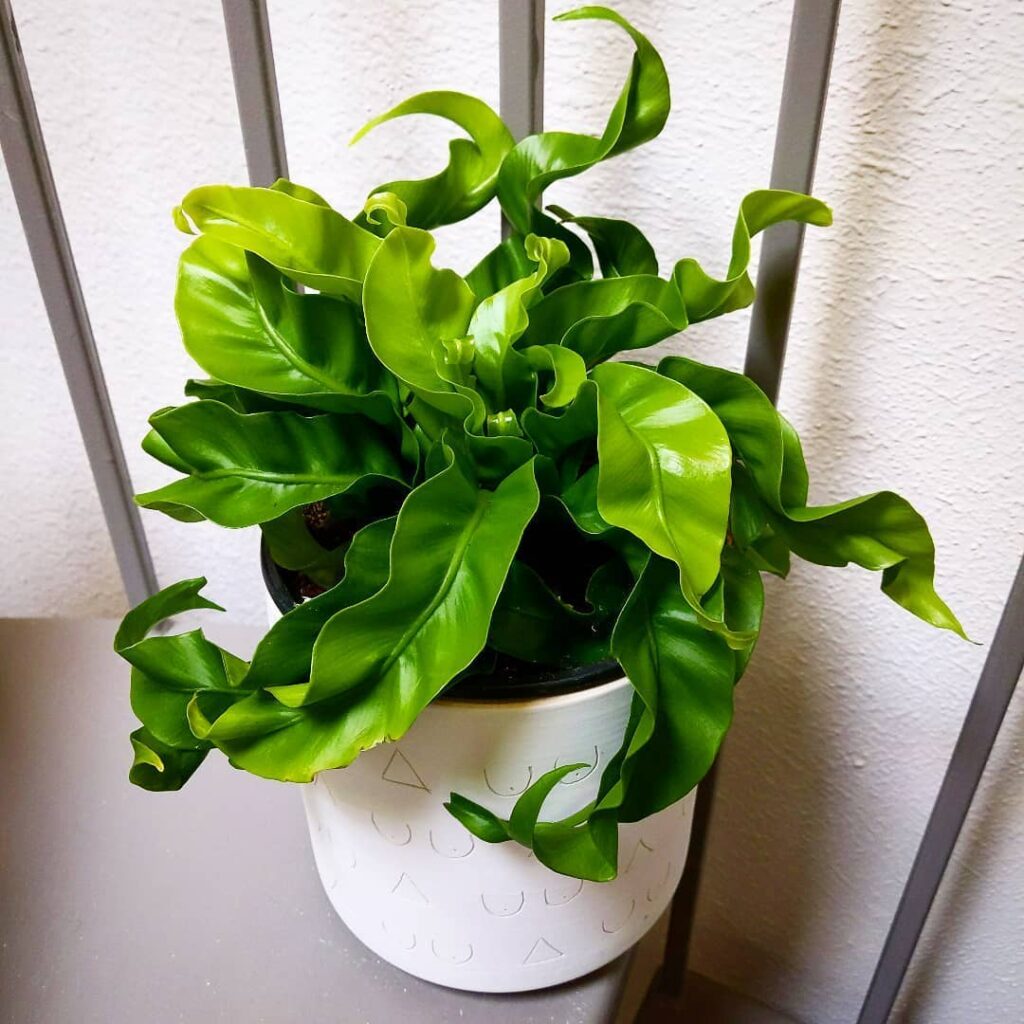
The Lacy Bird’s Nest Fern (Asplenium antiquum) is a striking epiphytic fern with distinctive fronds that emerge from a central rosette, resembling a bird’s nest. Unlike the typical Bird’s Nest Fern, this variety features deeply cut, rippled margins that give it a delicate, lace-like appearance. The fronds can grow up to 2 feet long and maintain a bright green color throughout their lifetime. This architectural plant adds texture and tropical flair to indoor spaces while remaining relatively compact.
- Light: Bright indirect light; avoid direct sunlight which can scorch leaves
- Water: Keep soil consistently moist but not waterlogged; mist regularly to maintain humidity
- Soil: Well-draining, organic potting mix rich in humus
- Temperature: 60-80°F (15-27°C)
- Humidity: High humidity (50% or higher)
- Fertilizer: Feed monthly with balanced liquid fertilizer during growing season
- Container: Pot with good drainage; can also be mounted on bark
- pH: Slightly acidic to neutral (6.0-7.0)
4. Polka-dot Plant
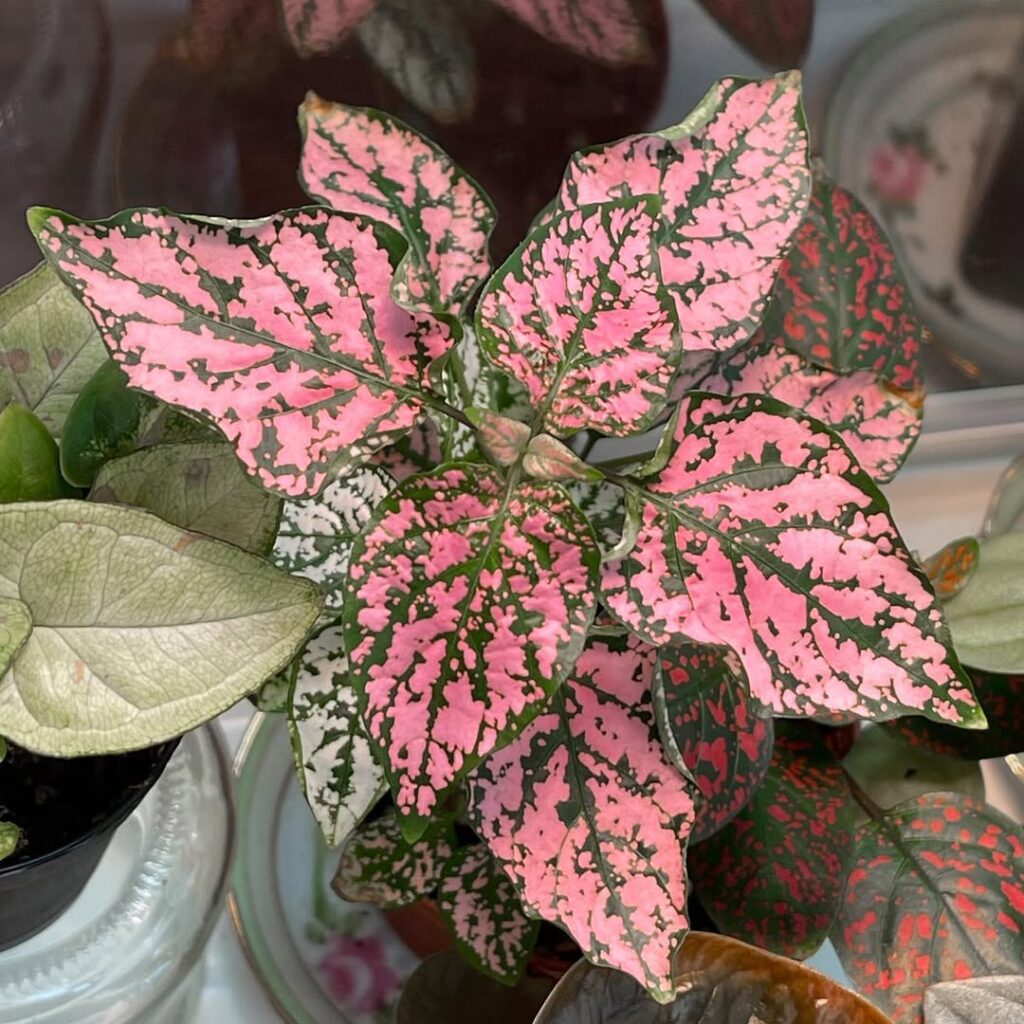
The heart-shaped polka-dot plant (Hypoestes phyllostachya) is a charming tropical specimen known for its distinctive foliage featuring pink, white, or red spots scattered across deep green leaves. This compact plant typically grows 12-18 inches tall and displays oval to lance-shaped leaves with dramatic spotting patterns that give it a whimsical, confetti-like appearance. Native to Madagascar, it’s commonly grown as a houseplant and can add a splash of color to indoor spaces year-round.
- Light: Bright, indirect light; protect from direct sun which can fade spots
- Water: Keep soil consistently moist but not waterlogged; water when top inch of soil feels dry
- Soil: Well-draining, rich potting mix with high organic content
- Humidity: Prefers high humidity levels; mist regularly or use a humidity tray
- Temperature: 65-80°F (18-27°C)
- Fertilizer: Feed monthly during growing season with balanced liquid fertilizer
- Pruning: Pinch back regularly to maintain bushiness and prevent legginess
5. Wandering Jew
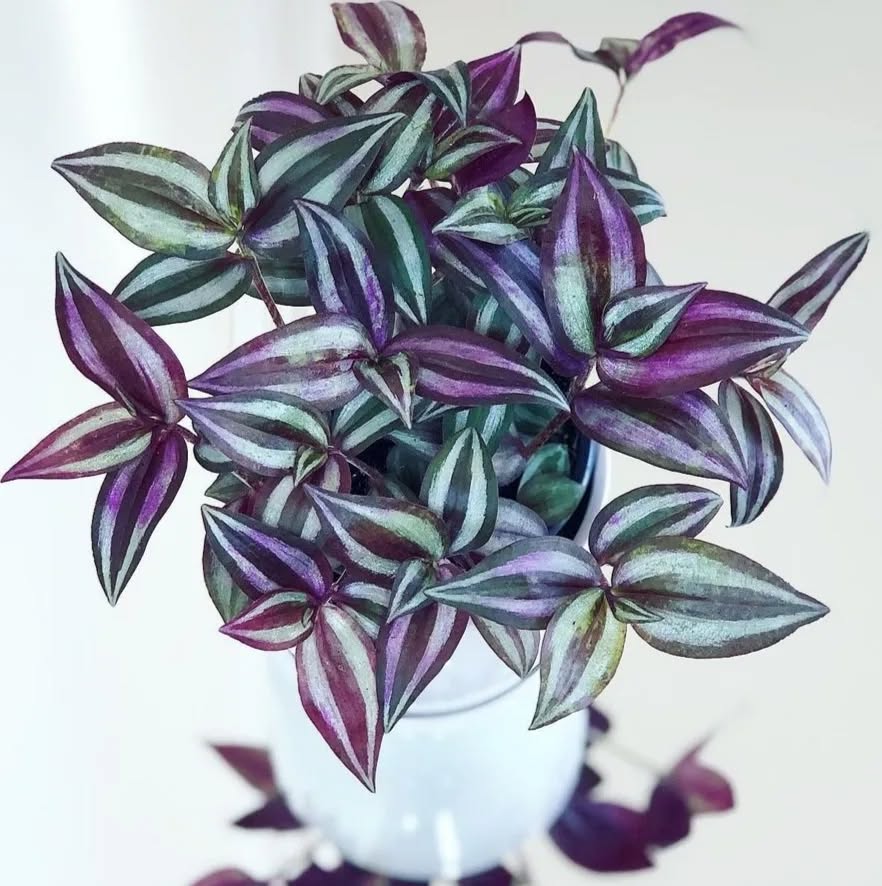
The Wandering Jew (Tradescantia zebrina) features striking purple and silver-striped leaves that make it a standout houseplant. Its trailing vines showcase leaves with deep purple undersides and metallic-looking stripes on top, creating an eye-catching display. The plant’s fast-growing nature and cascading habit make it perfect for hanging baskets or as a spiller in mixed container gardens, while its easy-care requirements have made it a popular choice among plant enthusiasts.
- Light: Bright, indirect light; can tolerate some direct morning sun but avoid harsh afternoon sunlight
- Water: Keep soil consistently moist but not waterlogged; water when top inch of soil feels dry
- Soil: Well-draining potting mix rich in organic matter
- Humidity: Prefers moderate to high humidity levels
- Temperature: 60-80°F (15-27°C)
- Fertilizer: Feed monthly during growing season with balanced, water-soluble fertilizer
- Pruning: Regular trimming of leggy stems to maintain fullness and promote bushier growth
6. Peacock Plant
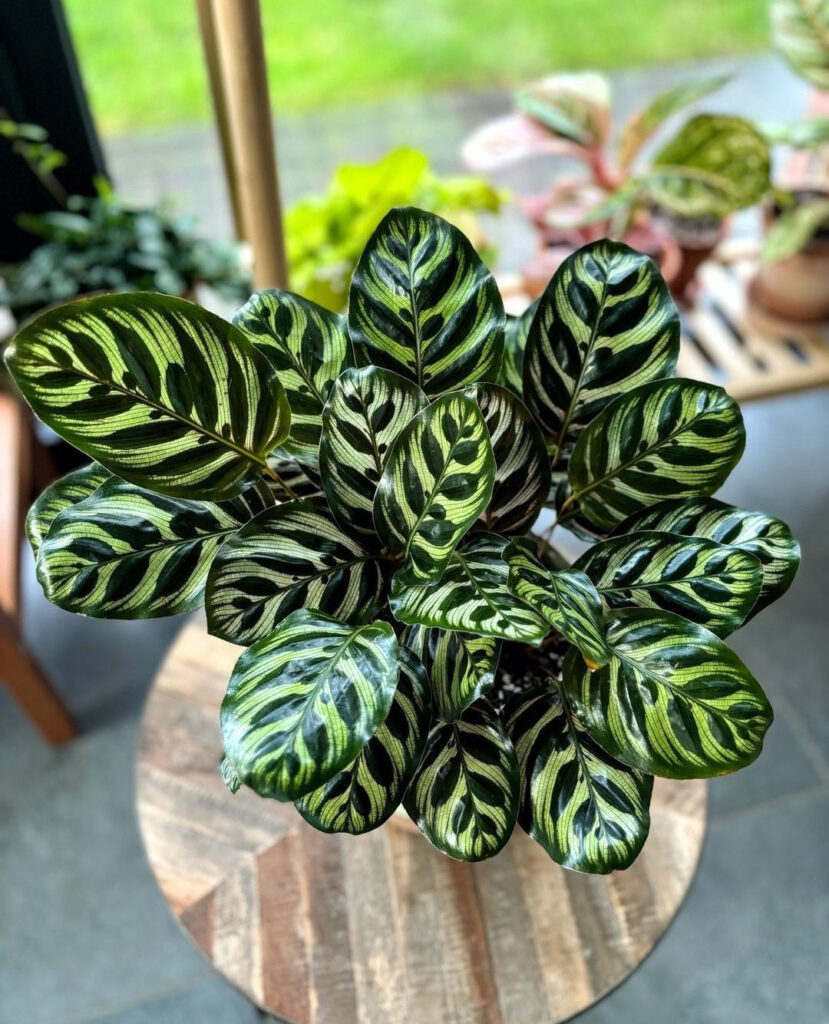
The Peacock Plant (Calathea makoyana) features stunning oval-shaped leaves with intricate feather-like patterns in varying shades of green on top and purple undersides. These decorative fronds move throughout the day in response to light, folding up at night and reopening in the morning, earning it the nickname “prayer plant.” The distinctive markings resemble peacock feathers, creating an eye-catching display that makes it a prized ornamental houseplant.
- Light: Bright indirect light; avoid direct sunlight which can fade the leaf patterns
- Water: Keep soil consistently moist but not waterlogged; water when top inch of soil feels dry
- Humidity: High humidity (60-70%); use a humidifier or pebble tray
- Soil: Well-draining, rich potting mix with organic matter
- Temperature: 65-80°F (18-27°C)
- Fertilizer: Feed monthly during growing season with balanced liquid fertilizer
- pH: 6.0-7.0 (slightly acidic to neutral)
7. Spider Plant
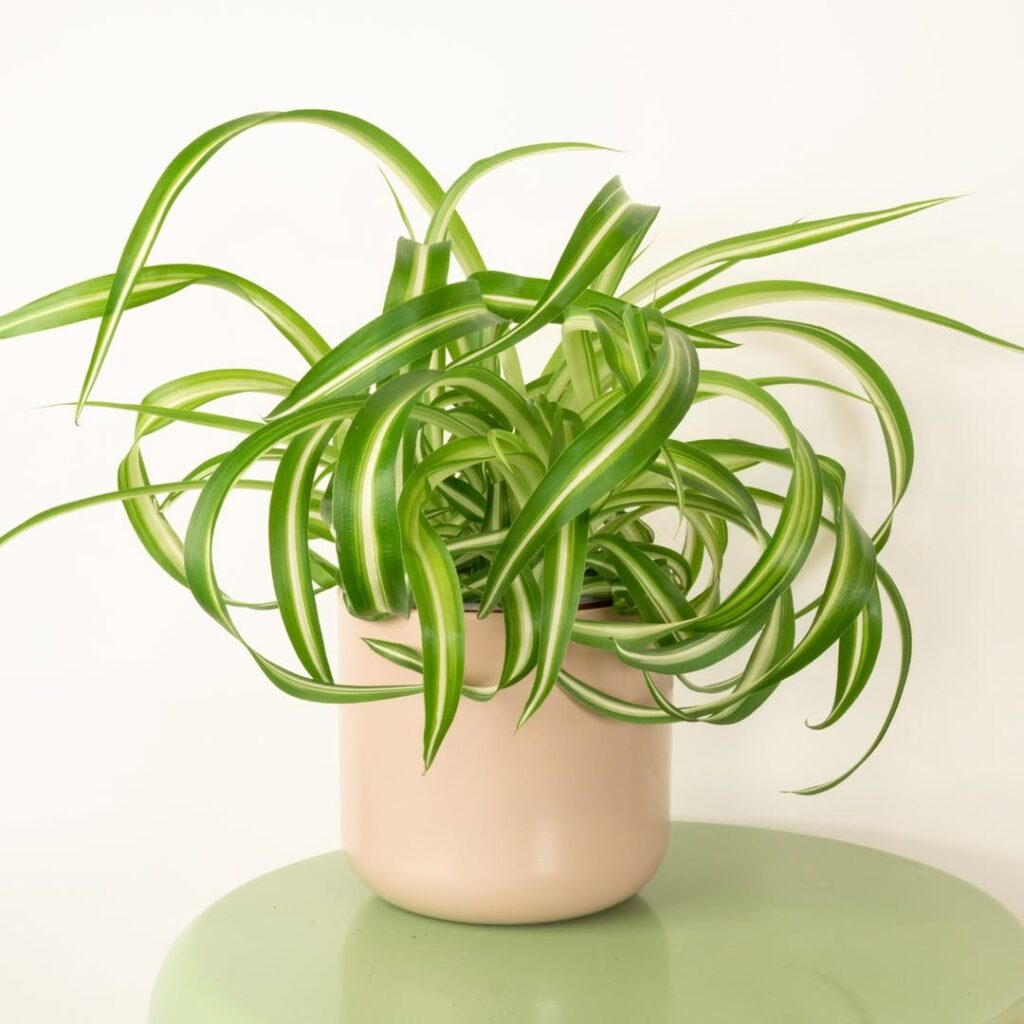
Spider plants feature distinctive, long, slender leaves that arch gracefully outward from the plant’s center, creating an elegant fountain-like appearance. These variegated leaves typically display green and white stripes, though some varieties show cream or yellow bands. As the plant matures, it produces long stems called stolons that dangle downward, bearing baby plants (plantlets) at their tips, adding to the plant’s cascading effect.
- Light: Bright, indirect light; can tolerate lower light but may lose variegation; avoid direct sunlight
- Water: Keep soil moderately moist; allow top inch to dry between waterings
- Soil: Well-draining, all-purpose potting mix
- Humidity: Tolerates average indoor humidity levels
- Temperature: 60-75°F (15-24°C)
- Fertilizer: Light feeding every 2-3 months during growing season
- Container: Pot with drainage holes; can grow well in hanging baskets
8. Snake Plant
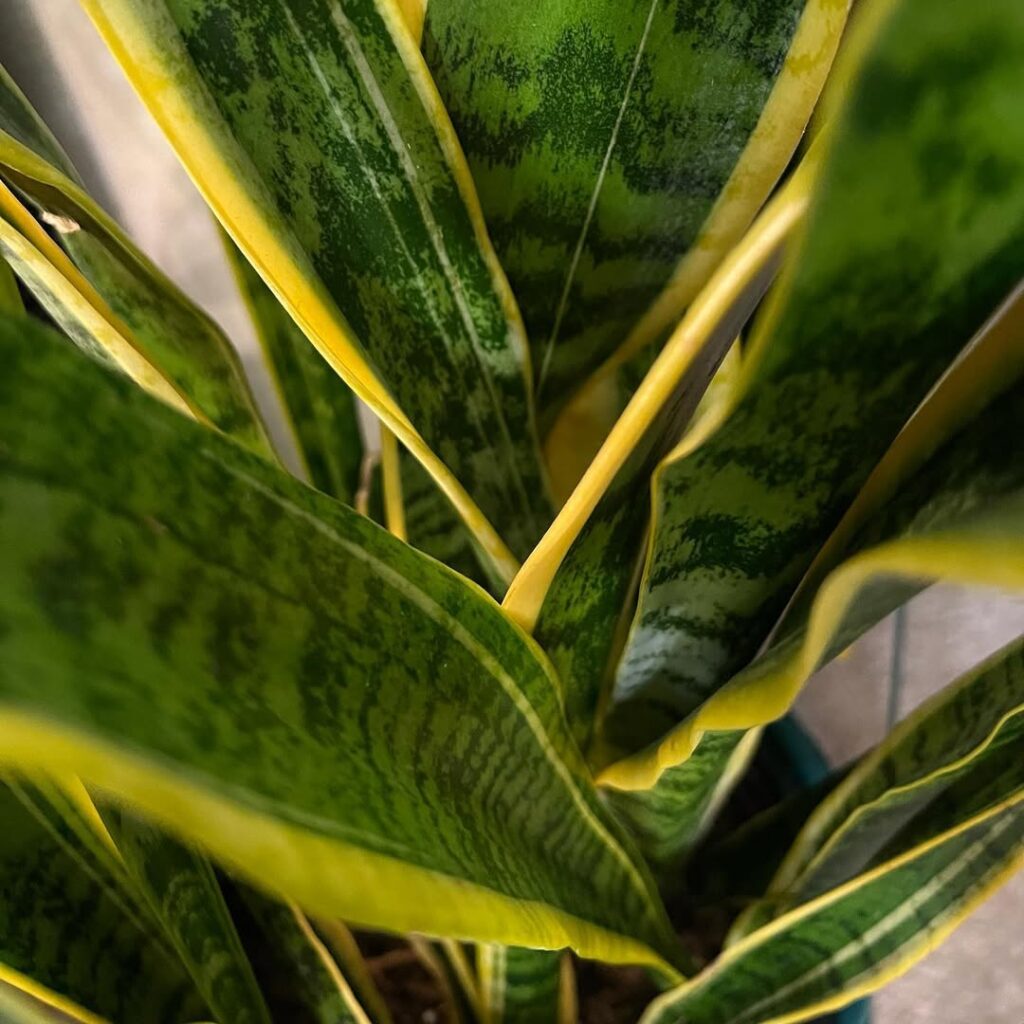
The snake plant‘s rigid leaves are one of its most distinctive features, growing as tall, upright sword-like blades that can reach heights of 2-4 feet. These thick, succulent leaves have sharp pointed tips and display striking patterns of green and yellow variegation, with some varieties featuring white or silver banding along their margins. The leaves grow in a dense, vertical arrangement from a thick rhizome system, creating an architectural statement that maintains its shape without flopping or bending.
- Light: Tolerates low light but thrives in bright indirect light; can handle some direct sun
- Water: Allow soil to dry between waterings; water sparingly in winter
- Soil: Well-draining potting mix; preferably succulent or cactus soil
- Humidity: Adaptable to various humidity levels; tolerates dry air
- Temperature: 70-90°F (21-32°C); can survive brief periods down to 50°F (10°C)
- Fertilizer: Light feeding with balanced fertilizer during growing season
- Pot Type: Container with drainage holes; terra cotta preferred for moisture control
9. Rubber Plant
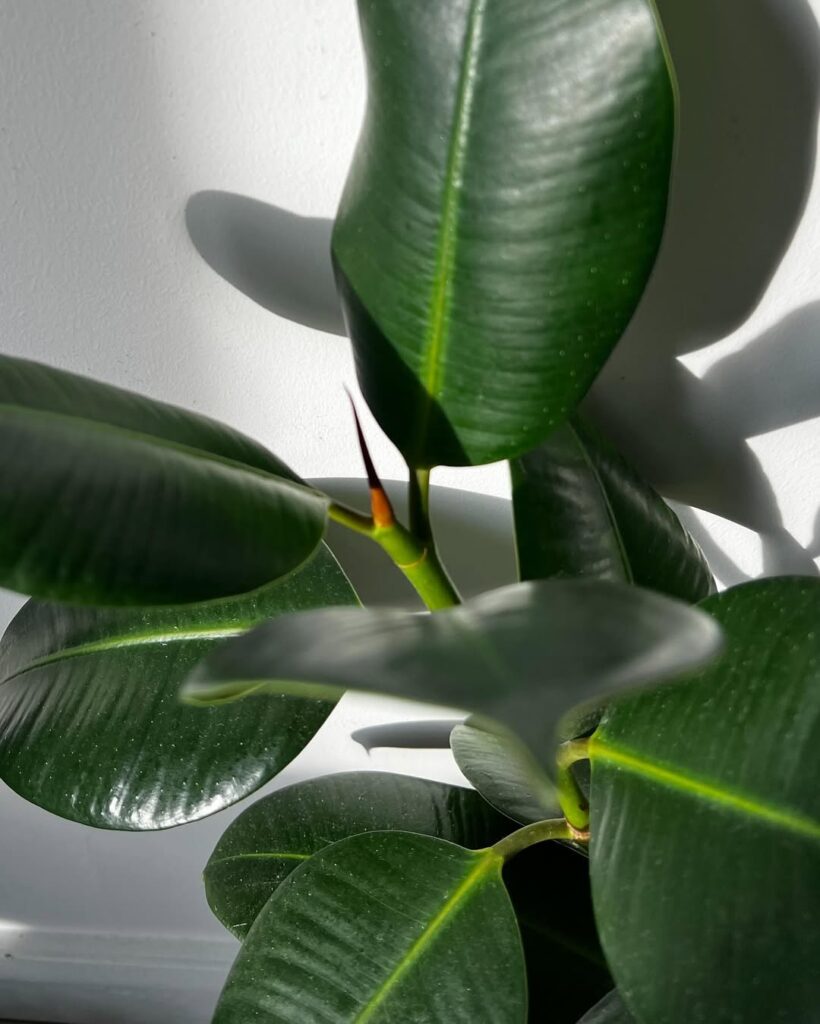
The rubber plant (Ficus elastica) is known for its striking, glossy leaves that reflect light and add a polished look to any room. These thick, leathery leaves can grow up to 12 inches long and feature a deep, natural shine that requires no artificial enhancement. The plant’s distinctive glossiness comes from a waxy coating that helps protect the leaves from water loss and environmental stress, while also giving them their characteristic mirror-like finish that has made them a favorite among indoor plant enthusiasts.
- Light: Bright, indirect light; can tolerate some direct morning sun but avoid harsh afternoon sunlight
- Water: Allow top 1-2 inches of soil to dry between waterings; reduce watering in winter
- Soil: Well-draining potting mix rich in organic matter
- Humidity: Moderate to high; benefits from regular misting
- Temperature: 60-75°F (15-24°C)
- Fertilizer: Feed monthly during growing season with balanced liquid fertilizer
- Maintenance: Wipe leaves occasionally with damp cloth to maintain shine and remove dust
10. Croton
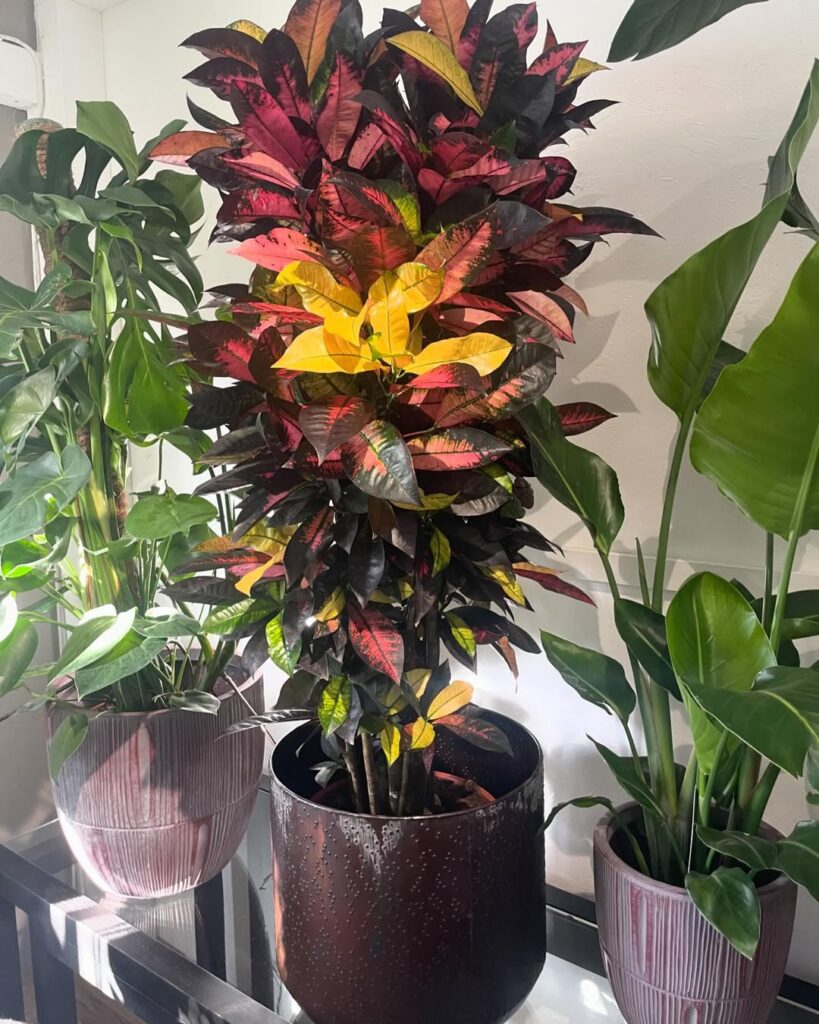
Croton (Codiaeum variegatum) plants feature some of the most striking and diverse leaf patterns in the houseplant world, displaying vibrant combinations of green, yellow, orange, red, purple, and black. The variations appear as spots, stripes, veining, and blocks of color that can change intensity based on light exposure. Each leaf is uniquely patterned, making every croton plant a distinct living work of art, with new leaves often emerging green before developing their signature multicolored appearance.
- Light: Bright, indirect sunlight; some direct morning sun acceptable; more light typically means more vibrant colors
- Water: Keep soil consistently moist but not waterlogged; water when top inch of soil feels dry
- Soil: Well-draining, rich potting mix with good organic content
- Humidity: High humidity (50-80%); regular misting or use of humidity tray beneficial
- Temperature: 60-80°F (15-27°C); protect from cold drafts
- Fertilizer: Monthly feeding during growing season with balanced fertilizer
- pH: Slightly acidic soil (pH 4.5-6.5)
11. Zebra Plant’s Striped Foliage
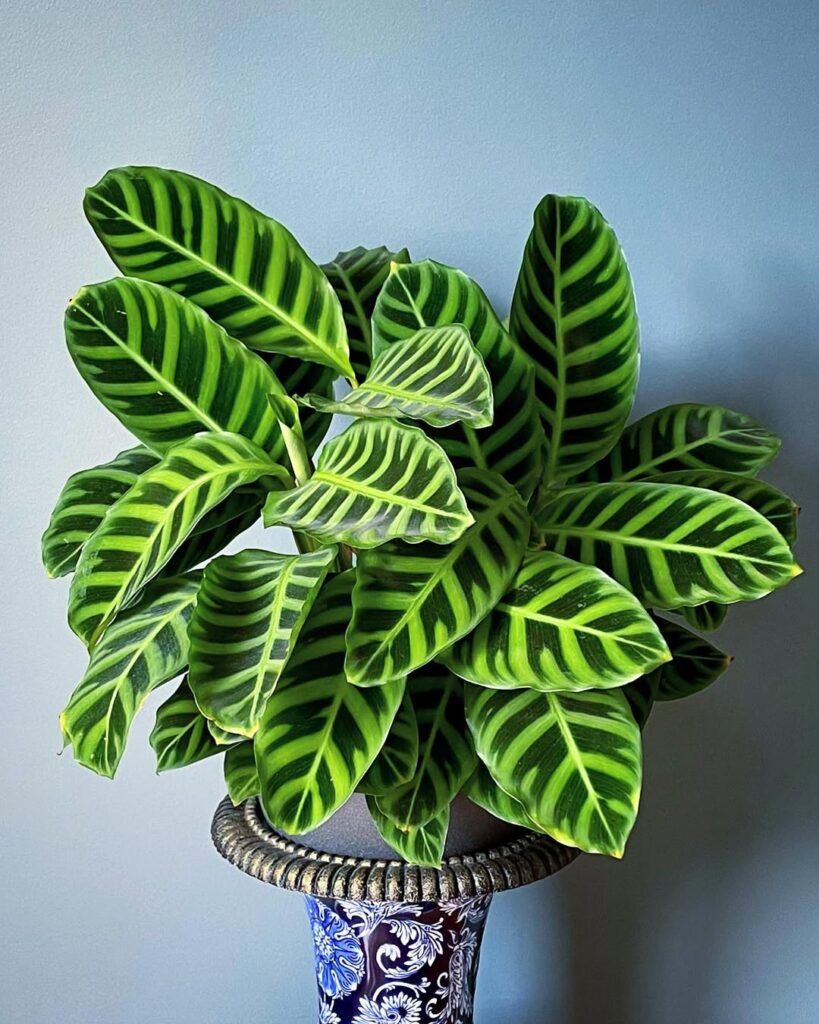
The Zebra Plant (Calathea zebrina) showcases dramatic foliage with distinctive dark green velvety stripes against a lighter green background, creating a pattern that resembles zebra markings. These large, oval leaves can grow up to 12 inches long and feature prominent veining that adds depth to their striking appearance. The leaves move throughout the day in response to light, lifting upward at night and lowering during daylight hours, a characteristic known as nyctinasty.
- Light: Bright indirect light; avoid direct sunlight which can fade the stripes
- Water: Keep soil consistently moist but not waterlogged; water when top inch of soil feels dry
- Humidity: High humidity (60% or higher); use humidifier or pebble tray
- Temperature: 65-75°F (18-24°C)
- Soil: Well-draining, rich potting mix with high organic content
- Fertilizer: Monthly feeding during growing season with balanced liquid fertilizer
- pH: 6.0-6.5 (slightly acidic)
12. Purple Passion
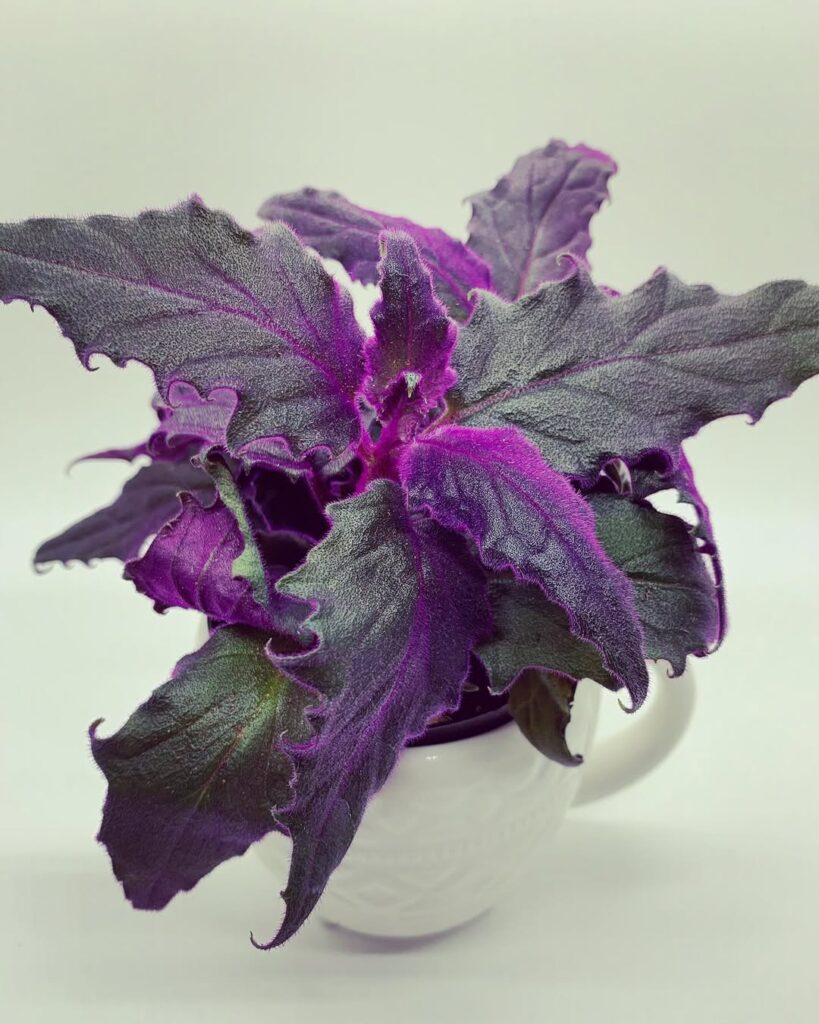
The Purple Passion plant (Gynura aurantiaca) stands out for its distinctive velvety leaves covered in soft, purple hairs that create an iridescent appearance against the green base foliage. This trailing plant features oval-shaped leaves with serrated edges, and the purple fuzz becomes more vibrant when exposed to bright light. While primarily grown for its unique foliage, it occasionally produces small orange flowers, though many growers remove them as they can emit an unpleasant odor.
- Light: Bright, indirect light; avoid direct sunlight which can fade the purple coloring
- Water: Keep soil consistently moist but not waterlogged; water when top inch of soil feels dry
- Soil: Well-draining, rich potting mix with added perlite
- Humidity: Moderate to high humidity (50-60%)
- Temperature: 60-75°F (15-24°C)
- Fertilizer: Feed monthly with balanced liquid fertilizer during growing season
- Pruning: Regular trimming to maintain shape and promote bushier growth
13. Pink Calathea
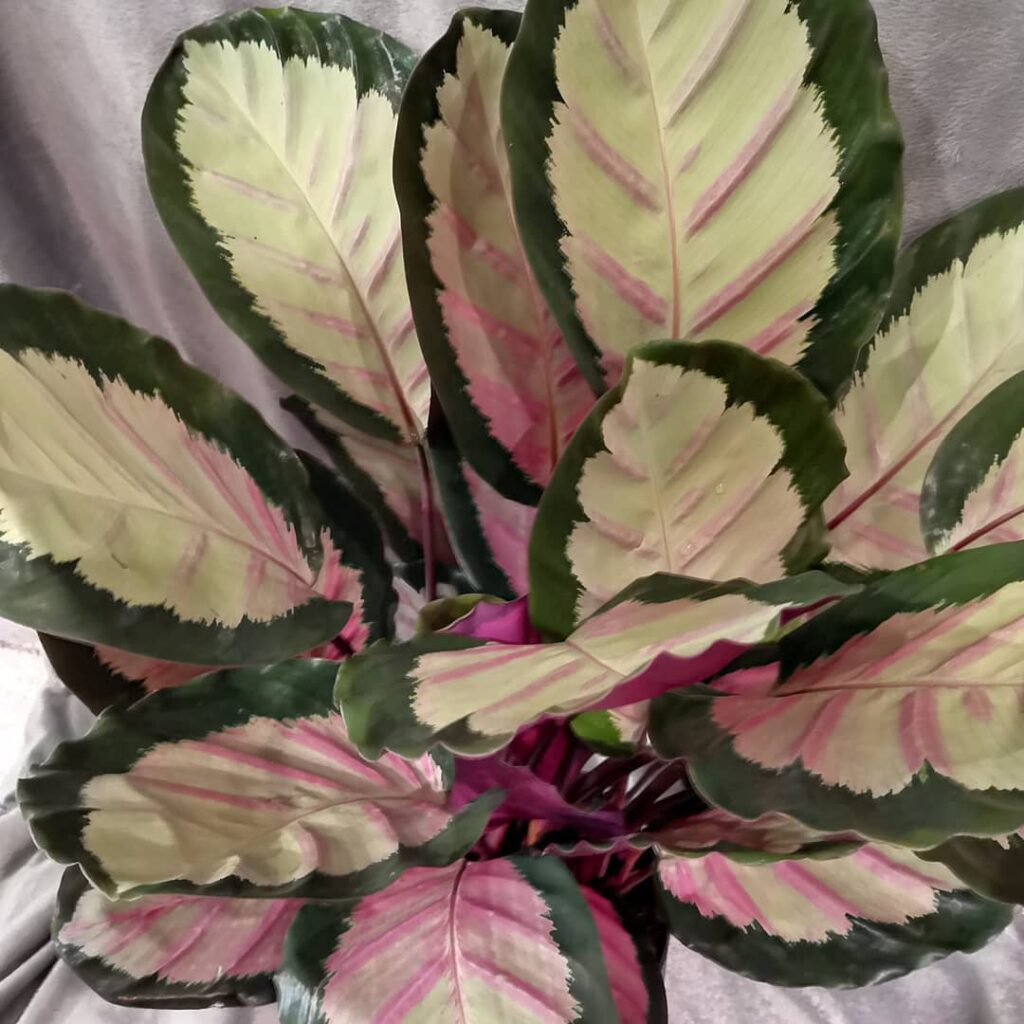
The Pink Calathea (Calathea roseopicta) features striking oval-shaped leaves with rippling patterns that combine deep green hues with pink or silvery-white markings. The leaves display a distinctive wavy texture along their edges and move throughout the day in response to light, a behavior known as nyctinasty. The undersides of the leaves are a rich burgundy color, adding to the plant’s ornamental appeal and making it a standout choice for indoor spaces.
- Light: Bright indirect light; avoid direct sunlight that can fade leaf patterns
- Water: Keep soil consistently moist but not waterlogged; water when top inch of soil feels dry
- Soil: Well-draining, rich potting mix with high organic matter
- Humidity: High humidity (60% or above); use humidifier or pebble tray
- Temperature: 65-80°F (18-27°C)
- Fertilizer: Monthly feeding during growing season with balanced liquid fertilizer
- Pot: Container with drainage holes to prevent root rot
- pH: Slightly acidic to neutral (6.0-7.0)
14. Moon Valley
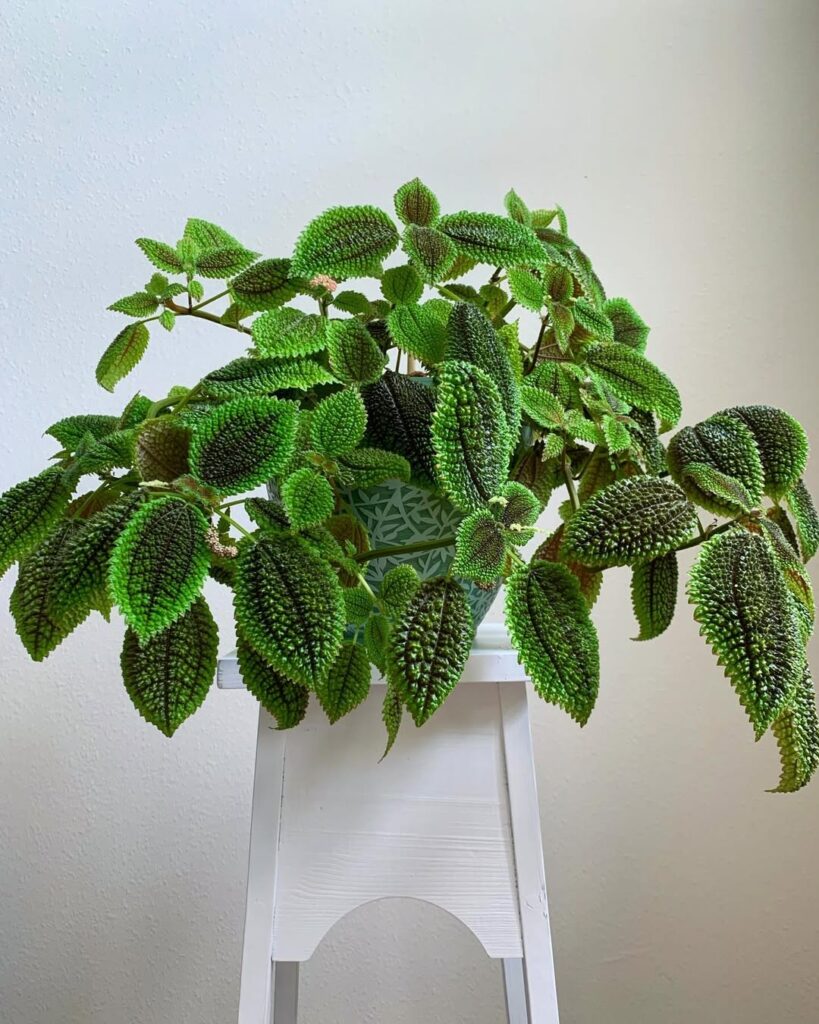
The Moon Valley plant (Pilea mollis) features deeply textured, crinkled leaves that create a distinctive quilted appearance. These dark green leaves have deep grooves between their veins, forming a pattern that resembles lunar landscapes, hence its common name. The leaves grow in a compact, bushy formation and can reach about 12 inches in height, making it an eye-catching houseplant for small spaces.
- Light: Bright, indirect sunlight; avoid direct sun which can scorch leaves
- Water: Keep soil consistently moist but not waterlogged; water when top inch of soil feels dry
- Soil: Well-draining potting mix rich in organic matter
- Humidity: Prefers high humidity levels around 60%
- Temperature: 65-75°F (18-24°C)
- Fertilizer: Feed monthly during growing season with balanced liquid fertilizer
15. Rex Begonia
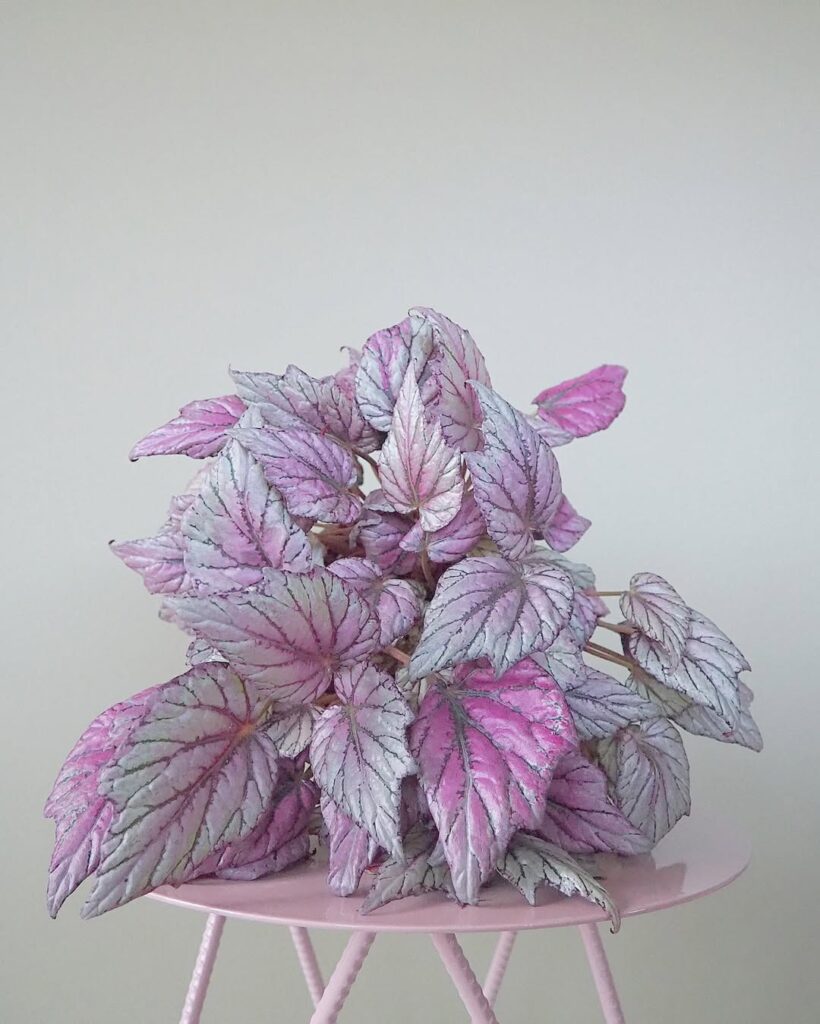
The Rex Begonia (Begonia rex-cultorum) is admired for its stunningly patterned and textured foliage, making it a standout houseplant. Its broad, asymmetrical leaves display swirls, spirals, and marbled patterns in shades of silver, deep reds, purples, and greens. The dramatic contrast and intricate designs give it a unique, artistic appeal that enhances any indoor space.
- Light: Bright, indirect light; avoid direct sun which can scorch the leaves
- Water: Keep soil consistently moist but not soggy; water when the top inch of soil feels dry
- Soil: Well-draining, peat-based mix with added perlite or sand
- Humidity: Prefers high humidity levels above 50%; thrives in terrariums or misted environments
- Temperature: 60-75°F (15-24°C); avoid cold drafts
- Fertilizer: Feed every 2-4 weeks with diluted balanced liquid fertilizer during active growth
